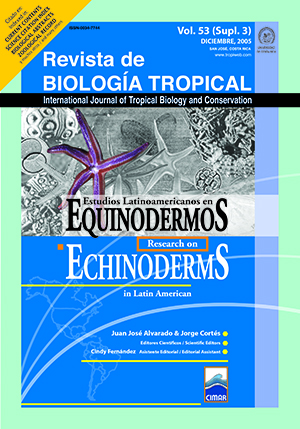Abstract
Echinoderms from Marino Ballena National Park, Pacific, Costa Rica. A total of 25 species of echinoderms (four asteroids, six ophiuroids, five echinoids and ten holothurians) were recorded at Marino Ballena National Park, using 25 m2 quadrants, parallel to the coast, at seven sites. The ophiuroids were the most abundant group with 581 individuals and the asteroids the less abundant (48 individuals). Echinoderms densities were low, with the exception of the ophiuroids. Diversity, density and the number of groups were higher where sedimentation was lower. We suggest that sedimentation is having a negative effect on the diversity of echinoderms and on the development of the coral reefs in this park. Rev. Biol. Trop. 53(Suppl. 3): 275-284. Epub 2006 Jan 30.References
Alvarado, J.J. 2004a. Descripción de las comunidades arrecifales del Parque Nacional Marino Ballena, Pacífico Central-Sur de Costa Rica. Tesis de Licenciatura, Universidad de Costa Rica, San Pedro, Costa Rica. 80 p.
Alvarado, J.J. 2004b. Abundancia del erizo de mar Centrostephanus coronatus (Echinoidea: Diadematidae) en el Pacífico de Costa Rica. Rev. Biol. Trop. 52: 911-913.
Anzo-Martínez, A. D. 1994. Los ofiuroideos (Echinodermata: Ophiuroidea) de las playas Pedregosa y Manzanillo, Zihuatanejo, Guerrero, México. Tesis Prof. Facultad de Biología. Univ. Michoacana de San Nicolás de Hidalgo, México. 47 p.
Bauer, J.C. 1980. Observations on geographical variations in population density of the echinoid Diadema antillarum within the western north Atlantic. Bull. Mar. Sci. 30: 509-515.
Brusca, R.C. 1980. Common Intertidal Invertebrates of the Gulf of California. 2nd ed., University of Arizona, Phoenix. 513 p.
Cantera, J.R., H. von Prahl, & R. Neira. 1987. Moluscos, crustáceos y equinodermos asociados a la gorgona Lophogorgia alba Duchassaing y Michelotti, 1864 en la Isla de Gorgona, Colombia. Bol. Ecotrop. 17: 3-23.
Caso, M. E. 1962. Estudios sobre equinodermos de México. Contribución al conocimiento de los equinodermos de las islas Revillagigedo. Anal. Inst. Biol. U.N.A.M. 33: 293-330.
Caso, M.E. 1978. Los equinoideos del Pacífico de México. Parte Primera- Ordenes Cidaroidea y Aulodonta- Parte Segunda- Ordenes Stiridonta y Camarodonta. Centro. Cienc. Mar Limnol. U.N.A.M., Publ. Esp. 1: 1-224.
Caso, M.E. 1980. Los equinoideos del Pacífico de México. Parte Tercera- Orden Clypeasteroida. Centro. Cienc. Mar Limnol. U.N.A.M, Publ. Esp. 4: 1-252.
Caso, M.E. 1983. Los equinoideos del Pacífico de México. Parte cuarta- Ordenes Cassiduloida y Spantangoida. Inst. Centro. Cienc. Mar Limnol. U.N.A.M, Publ. Esp. 6: 1-200.
Caso, M.E. 1994. Estudio morfológico, taxonómico, ecológico y distribución geográfica de los asteroideos colectados durante las campañas oceanográficas Cortés 1, 2, 3. Inst. Cienc. Mar Limnol. U.N.A.M, Publ. Esp. 12: 1-111.
Clark, H.L. 1940. Eastern Pacific Expeditions of the New York Zoological Society. XXI. Notes on Echinoderms from the West Coast of Central America. Zoologica 25: 331-352.
Clark, H.L. 1948. A report on the Echini of the warmer eastern Pacific, based on the collections of the Velero III. Allan Hancock Pac. Exp. 8: 225-352.
Deichmann, E. 1941. The Holothurioidea collected by the Velero III during the years 1932 to 1938. Part I. Dendrochirota. Allan Hancock Pac. Exp. 8: 61-195.
Deichmann, E. 1958. The Holothurioidea collected by the Velero III and IV during the years 1932 to 1954. Part II. Aspidochirota. Allan Hancock Pac. Exp. 11: 253-349.
Field, J.G., K.R. Clarke & R.M. Warwick. 1982. A practical strategy for analyzing multispecies distribution patterns. Mar. Ecol. Prog. Ser. 8: 37-52.
Grignard, J.C., P. Flammang, D.J.W. Lane & M. Jangoux. 1996. Distribution and abundance of the echinoid Diadema setosum (Echinodermta) on sedimentstressed coral reefs in Singapore. Asian Mar. Biol. 13: 123-132.
Guzmán, H.M. 1988. Distribución y abundancia de organismos coralívoros en los arrecifes coralinos de la Isla del Caño, Costa Rica. Rev. Biol. Trop. 36: 191-207.
Hendler, G., J.E. Miller, D.L. Pawson & P.M. Kier. 1995. Sea Stars, Sea Urchins, and Allies: Echinoderms of Florida and the Caribbean. Smithsonian Institution, Washington & London. 390 p.
Hertlein, L.G. 1963. Contribution to the biogeography of Cocos Island, including a bibliography. Proc. Cal. Acad. Sci. 32: 123-235.
Hickman, C.P. Jr. 1998. A Field Guide to Sea Stars and other Echinoderms of Galápagos. Sugar Spring, Virginia. 83 p.
Holguín-Quiñones, O., H. Wright López & F. A. Solís Marín. 2000. Asteroidea, Echinoidea y Holothuroidea en fondos someros de la Bahía de Loreto, Baja California Sur, México. Rev. Biol. Trop. 48: 749-757.
Jiménez, C.E. 1995. Capítulo 4: Ambientes marino-costeros, p. 31-39. In Plan general de manejo, Área de Conservación Osa, Anexo 1, Sondeo ecológico rápido, tomo 2. SPN, FUNDEVI, PROAMBI, ICT.
Maurer, D. & J.A Vargas. 1983. Benthic studies in the Gulf of Nicoya, Costa Rica. University of Delaware, College of Marine Studies. Lewes: 1-105.
Maurer, D., C. Epifanio, H. Dean, S. Howe, J.A. Vargas, A. Dittel & M.M. Murillo. 1984. Benthic invertebrate of a tropical estuary: Gulf of Nicoya, Costa Rica. J. Nat. Hist. 18: 47-61.
Miskelly, A. 2002. Sea Urchins of Australia and the Indo- Pacific. Capricornia, Sydney, Australia.179 p.
Reyes-Bonilla, H. 1995. Asteroidea and Echinoidea (Echinodermata) of Isla San Benedicto, Revillagigedo Archipelago, Mexico. Rev. Inv. Cient. Ser. Cien. Mar. UABCS 6: 29-38.
Sammarco, P.W., J.S. Levinton & J.C. Ogden.1974. Grazing and control of coral reef community structure by Diadema antillarum Philippi (Echinodermata: Echinoidea) a preliminary study. J. Mar. Res. 32: 47-53.
Vázquez-Domínguez, E. 2003. Diversidad y distribución de crustáceos y equinodermos y su relación con los niveles de sedimentación en arrecifes coralinos. Rev. Biol. Trop. 51: 183-194.
##plugins.facebook.comentarios##

This work is licensed under a Creative Commons Attribution 4.0 International License.
Copyright (c) 2005 Revista de Biología Tropical






